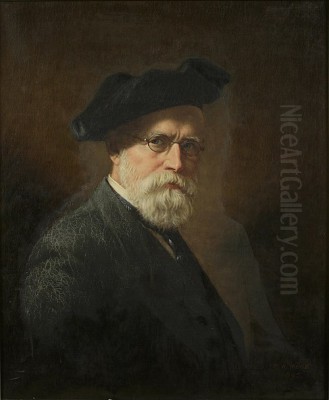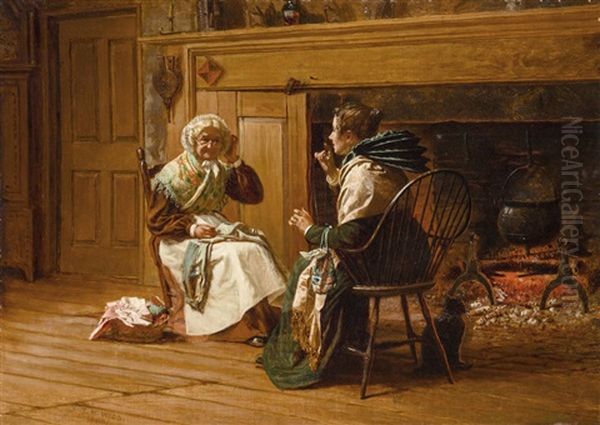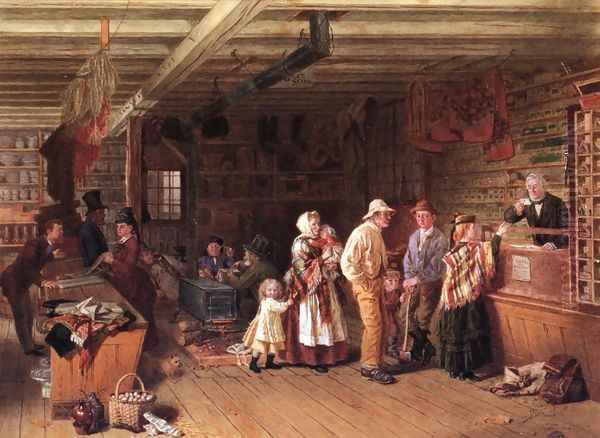
Thomas Waterman Wood stands as a significant, if sometimes overlooked, figure in nineteenth-century American art. An artist whose career spanned a transformative period in the United States, from the antebellum era through the Civil War, Reconstruction, and into the Gilded Age, Wood dedicated his talents to capturing the multifaceted character of American life. His work, primarily in oil on canvas, engaged with themes of national identity, social change, and the everyday experiences of ordinary people. He was a keen observer, and his paintings often carried layers of narrative and social commentary, reflecting the complexities of his time, particularly concerning issues of race, citizenship, and community.
Early Life and Artistic Formation
Born on November 12, 1823, in Montpelier, Vermont, Thomas Waterman Wood's artistic inclinations emerged early in his life. Growing up in a New England town provided him with an initial palette of American character types and landscapes that would subtly inform his later work. While detailed records of his earliest artistic training are somewhat sparse, it is known that he sought instruction to hone his natural talents. Like many aspiring American artists of his generation, he looked to established figures for guidance.
His formative period included study in Boston around 1846, where he worked in the studio of the prominent portrait painter Chester Harding. Harding, known for his direct and unpretentious likenesses of many notable figures of the era, including Daniel Webster and John C. Calhoun, would have provided Wood with a solid grounding in portraiture techniques. This early exposure to portrait painting likely instilled in Wood an appreciation for capturing individual character, a skill that would become evident even in his more complex genre scenes.

Seeking to broaden his artistic horizons, Wood, like many of his ambitious contemporaries such as William Morris Hunt or Worthington Whittredge who also sought European training, traveled to Europe in 1858. He spent time in Paris, studying with Thomas Couture, a highly respected French academic painter. Couture's atelier was a popular destination for international students, and his emphasis on strong drawing, tonal values, and expressive compositions would have been influential. Other American artists who passed through Couture's studio or were influenced by similar academic traditions included Eastman Johnson, who would also become renowned for his genre scenes of American life. This European sojourn exposed Wood to a wider range of artistic styles and techniques, from the academic precision of the Salon to the emerging realism that was beginning to challenge established norms.
A Career Across America
Upon his return to the United States, Wood did not immediately settle in one location. Instead, his career saw him working in various cities, which provided him with diverse subject matter and a broader understanding of the American social fabric. He spent time in Nashville, Tennessee, from 1859, and later in Louisville, Kentucky, during the tumultuous years of the Civil War. His experiences in the South during this critical period undoubtedly shaped his perspective and provided him with firsthand observations of the social and racial dynamics that he would later explore in his art.
After the Civil War, Wood moved to New York City in 1866, which was rapidly becoming the undisputed center of the American art world. Here, he became an active participant in the city's artistic life. He was elected an Associate of the prestigious National Academy of Design in 1869 and became a full Academician in 1871. The National Academy, founded by artists like Samuel F.B. Morse and Asher B. Durand, was a vital institution for American artists, providing exhibition opportunities and fostering a sense of community. Wood would later serve as its president from 1891 to 1899, a testament to his standing among his peers. His contemporaries at the Academy included leading landscape painters of the Hudson River School like Frederic Edwin Church and Albert Bierstadt, as well as fellow genre painters.
Artistic Style: Realism, Narrative, and Social Observation
Thomas Waterman Wood's primary artistic style can be characterized as a form of narrative realism, deeply rooted in the tradition of American genre painting. Genre painting, which focuses on scenes of everyday life, gained immense popularity in the United States during the nineteenth century, with artists like William Sidney Mount and George Caleb Bingham being notable early practitioners. Wood continued and expanded upon this tradition, infusing his works with a particular attention to detail, character study, and often, subtle social commentary.

His paintings are distinguished by their careful draftsmanship, clear compositions, and a palette that, while not always vibrant, was effective in conveying mood and atmosphere. He had a talent for capturing the textures of fabrics, the character in a weathered face, and the small details that lend authenticity to a scene. Wood's approach often drew from the visual language of popular illustration and news reporting of the era, making his works accessible and engaging to a broad audience. He was less interested in the idealized or romanticized visions of some of his contemporaries and more focused on the tangible realities of American society.
A significant aspect of Wood's oeuvre is his depiction of African Americans, particularly in the post-Civil War period. At a time when representations of Black individuals in art were often stereotypical or caricatured, Wood frequently portrayed them with dignity and individuality. His works in this vein are considered important contributions to the visual discourse on race and citizenship during Reconstruction and its aftermath. He shared this interest with contemporaries like Eastman Johnson and Winslow Homer, who also created significant works depicting the lives of African Americans.
Pivotal Works: American Citizens (To the Polls)
One of Thomas Waterman Wood's most significant and widely discussed works is the triptych or series known as American Citizens (To the Polls), painted in 1867, shortly after the passage of the 14th Amendment, which granted citizenship to African Americans, and in anticipation of the 15th Amendment, which would grant Black men the right to vote. This series is a powerful visual statement on the changing nature of American democracy and the complexities of enfranchisement.
The series typically depicts four distinct "types" of American voters, reflecting the diverse, and often contentious, makeup of the electorate. These often include an Irish immigrant, an elderly Yankee farmer, a German immigrant, and, most notably, an African American man, often portrayed as a Union Army veteran. By placing these figures side-by-side, Wood highlighted the expansion of suffrage and visually interrogated the meaning of citizenship in a nation grappling with the legacy of slavery and the integration of new immigrant populations.
The depiction of the African American voter is particularly poignant. Often shown with a sense of quiet dignity and purpose, this figure challenged prevailing racist stereotypes and asserted the Black man's rightful place in the American political landscape. Wood's careful rendering of this figure, sometimes with a missing limb to signify his service and sacrifice in the Civil War, added another layer of meaning, underscoring the contributions of African Americans to the preservation of the Union. This work stands as a crucial historical document, reflecting both the hopes and the underlying tensions of the Reconstruction era. It engages with themes similar to those explored by Winslow Homer in works like A Visit from the Old Mistress (1876), which also delved into the new social dynamics of the post-war South.
Strictly Confidential: A Glimpse into Everyday Life
Another notable work by Thomas Waterman Wood is Strictly Confidential, an oil on canvas completed in 1880, measuring 50.8 cm by 71.1 cm. While the current location of this painting is cited as unknown in some records, its subject matter aligns with Wood's interest in genre scenes that capture moments of everyday human interaction. The title itself suggests a narrative of shared secrets, gossip, or intimate conversation, themes common in genre painting that invite the viewer to speculate and engage with the story being told.
Without the image readily available for detailed analysis, one can surmise that Strictly Confidential likely features a small group of figures, perhaps two or three, engaged in a private exchange. Wood's skill in rendering facial expressions and body language would have been crucial in conveying the "confidential" nature of the interaction. The setting, whether a domestic interior or a more public space, would also contribute to the narrative. Such paintings often provided a window into the social customs and mores of the time.
This type of intimate genre scene was popular in the latter half of the nineteenth century, both in America and Europe. Artists like Lilly Martin Spencer in America, or various Victorian painters in Britain, often explored domestic narratives and moments of quiet drama or humor. Wood's contribution to this genre would have been marked by his characteristic realism and his ability to imbue ordinary scenes with a sense of authenticity and relatable human experience.
Other Themes and Subjects
Beyond his well-known works addressing citizenship and his intimate genre scenes, Thomas Waterman Wood's oeuvre encompassed a range of subjects. He was an accomplished portrait painter throughout his career, a skill honed from his early days with Chester Harding. His portraits were valued for their likeness and their straightforward, unembellished style. He painted prominent citizens, family members, and fellow artists, contributing to the rich tradition of American portraiture that included artists from John Singleton Copley in the colonial era to John Singer Sargent in Wood's later years.
Wood also painted scenes related to the Civil War, often focusing on the experiences of common soldiers and the impact of the war on individuals and families. These works, sometimes depicting soldiers returning home or moments of camp life, resonated with a public deeply affected by the conflict. His interest in narrative and human emotion found a powerful outlet in these subjects.
Furthermore, his body of work includes numerous character studies, often focusing on elderly figures or distinctive local "types" he encountered in Vermont and elsewhere. These studies demonstrate his keen eye for detail and his fascination with the diversity of American character. They align with a broader nineteenth-century interest in physiognomy and the representation of regional identities, an interest also seen in the works of illustrators like Thomas Nast, who often used distinct visual types in his political cartoons.
Wood as an Educator and Institutional Figure
Thomas Waterman Wood's influence extended beyond his own artistic production. His long association with the National Academy of Design, culminating in his presidency, placed him in a position of leadership within the American art establishment. During his tenure, he would have overseen exhibitions, helped shape the Academy's policies, and mentored younger artists. The Academy was a crucial institution for artists like Sanford Robinson Gifford, Jervis McEntee, and many others who sought to establish their careers.
A particularly lasting aspect of Wood's legacy is the T.W. Wood Gallery & Arts Center, which he founded in his hometown of Montpelier, Vermont, in 1895. He endowed the gallery with a significant portion of his own work, as well as copies he had made of European Old Master paintings. His vision was to create an institution that would bring art to his local community and provide educational opportunities. The gallery continues to operate today, preserving his legacy and serving as a cultural resource for the region. This act of philanthropy demonstrates his commitment to the democratizing potential of art and his desire to give back to the community that shaped him.
The mention of Wood being Chester H. Harding's teacher in the provided information is an interesting point. Given that Harding (1792-1866) was significantly older than Wood (1823-1903) and an established painter by the time Wood was beginning his studies, it is almost certain that Wood was a student of Harding, or at least studied in his Boston studio, rather than the other way around. This is a common type of inversion that can occur in historical records if not carefully cross-referenced. Wood's role as an educator is more clearly defined by his later activities and his founding of the gallery.
Later Career and Enduring Legacy
Thomas Waterman Wood continued to paint into his later years, remaining committed to his realist style even as new artistic movements like Impressionism began to gain traction in America, championed by artists such as Mary Cassatt and Childe Hassam. While his style might have seemed more traditional by the turn of the century, his dedication to depicting American life and character remained constant.
He passed away on April 14, 1903, in New York City, leaving behind a substantial body of work that offers valuable insights into nineteenth-century American society. His paintings are held in numerous public and private collections, including the T.W. Wood Gallery & Arts Center, the Fine Arts Museums of San Francisco, and other institutions that recognize his contribution to American art.
The art of Thomas Waterman Wood is particularly relevant today for its engagement with themes of social justice and national identity. Works like American Citizens (To the Polls) continue to provoke discussion about the history of voting rights and the ongoing struggle for equality. His dignified portrayals of African Americans stand as important counter-narratives to the racist imagery prevalent in much of nineteenth-century popular culture. He was an artist who used his skills to document, comment on, and participate in the great social and political dramas of his time. His realism, while perhaps not as gritty as that of later artists like Thomas Eakins or the Ashcan School painters such as Robert Henri, was nonetheless a committed attempt to represent the world around him with honesty and empathy.
Conclusion
Thomas Waterman Wood was an American artist of considerable talent and social conscience. His journey from rural Vermont to the art capitals of Boston, Paris, and New York equipped him with the skills and perspectives necessary to create a body of work that is both historically significant and artistically accomplished. Through his genre scenes, portraits, and particularly his insightful depictions of African Americans during the Reconstruction era, Wood provided a nuanced visual record of nineteenth-century American life. His dedication to narrative realism, his engagement with pressing social issues, and his lasting contribution through the founding of the T.W. Wood Gallery ensure his place in the annals of American art history. As we continue to explore the complexities of America's past, the works of Thomas Waterman Wood offer a valuable and often moving perspective.